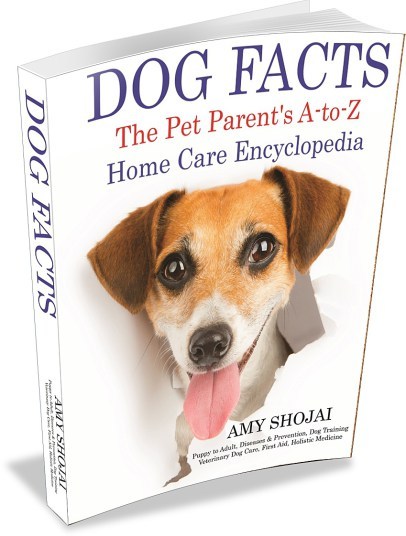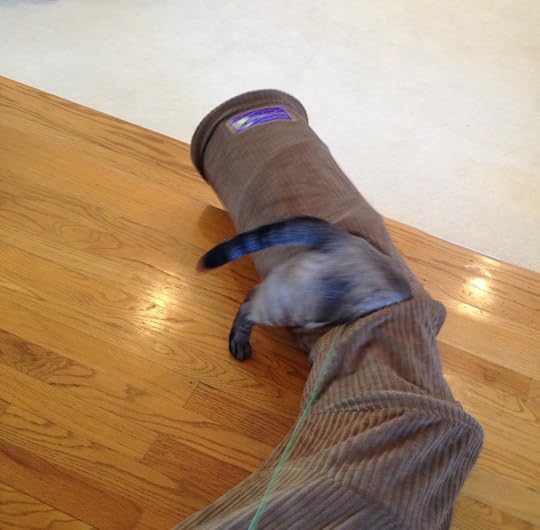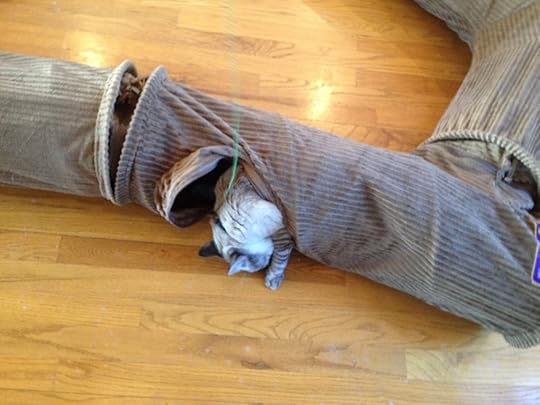Amy Shojai's Blog, page 84
March 14, 2016
Pre-order Now! DOG FACTS, The Pet Parent’s A-to-Z Home Care Encyclopedia
DOG FACTS Pre-order Sale!
Kindle discounted from $9.99 to $2.99 until Wednesday March 16, 2106
This book has been 25 years in the making…may it be a boon to all of your canine companions. The print version ($24.99) boasts 650+ pages with more than 200 photos & charts, and releases along with all Ebook formats on APRIL 18, 2016.
THE PERFECT DOG BOOK!
More than 78 million pet dogs today are kept in fifty-four million U.S. households. Now, from one of the most trusted dog care authors of the last twenty-five years comes the definitive reference for adopting, keeping, and maintaining a healthy, happy dog. DOG FACTS: The Pet Parent’s A-to-Z Home Care Encyclopedia is designed to answer all your questions. How do I choose the right dog? What holistic help and preventive care should I give? Why do dogs act the way they do, and what dog behavior indicates illness? What constitutes an emergency, and how/when can I safely treat my dog with home care and first aid? Inside you’ll find:
An alphabetical A-to-Z listing, with more than 200 entries and 200+ cute dog photos and illustrations, covering everything from abscesses and hair loss to whipworms and zoonosis
Charts that list symptoms for a particular condition, the corresponding home care or first aid, the comparative veterinarian and holistic treatments, and preventive advice
A symptoms/conditions table that helps you identify what ailments might be bothering your dog
Breed-At-A-Glance chart to compare personality, looks, care challenges and other issues when choosing your purebred dog
A comprehensive, easy-to-use index that makes quick reference a snap
Contact information for dozens of dog organizations and veterinary resources
Accessible, yet comprehensive, DOG FACTS can be used with ease and trust. And doesn’t your dog deserve the very best?
Pre-order Here:
KINDLE
NOOK
iTUNES
KOBO
I love hearing from you, so please share comments and questions. Do you have an ASK AMY question you’d like answered? Do you have a new kitten and need answers? Stay up to date on all the latest just subscribe the blog, “like” me on Facebook, and sign up for Pet Peeves newsletter. Stay up to date with the latest book give aways and appearances related to my September Day pet-centric THRILLERS WITH BITE!
March 10, 2016
Thriller Thursday: John Connell & Spoils of Victory

Chills, thrills and spills with Thriller Thursday by Amy Shojai
THRILLER THURSDAY is a new occasional feature of Bling, Bitches & Blood. As a member of International Thriller Writers and alumni of the ITW Debut Author Program, it is my honor to showcase select ITW authors and books participating in the ITW Bloggers Program. If you love reading great books as much as I do, check out my guest John Connell!
John A. Connell is the author of Ruins of War, and has worked as a cameraman on films such as Jurassic Park and Thelma & Louise and on TV shows including The Practice and NYPD Blue. Spoils of Victory is his second historical thriller featuring Mason Collins. He now lives with his wife in Madrid, Spain, where he is at work on his third novel.
Synopsis:
Former Chicago police detective, soldier, POW, and now-U.S. Army criminal investigator Mason Collins finds himself in Garmisch-Partenkirchen, a scenic Alpine ski town that managed to escape the destruction of the war. Garmisch-Partenkirchen is a far cry from Mason’s last harrowing post in the American Zone of Occupation in Munich just months after the Nazi’s defeat. But it is also the home of fleeing war criminals, a depository for the Nazis’ stolen riches. With millions of dollars to be made on the black market, murder, extortion, and corruption have become commonplace.
When an old war buddy of Mason’s, CIC Agent John Winstone, alerts him about a plot of a group of powerful men to take over the lucrative trade popping up there, Winstone and his girlfriend are brutally murdered. Determined to uncover the truth, Mason plunges into a shadowy labyrinth of co-conspirators including former SS and Gestapo officers, U.S. Army OSS officers, and liberated Polish POWs. As more witnesses and then evidence begin disappearing, it becomes obvious that someone on high is pulling strings to stifle the investigation—and that Mason must feel his way in the darkness if he is going to find out who in town has the most to gain—and the most to lose.
“A second installment just as terrific as the first – this is going to be a must-read series for me.” ~ Lee Child, #1 New York Times bestselling author of the Jack Reacher novels
“Excitement melds with adventure as the tangled threads gradually unwind, revealing treachery coming from all directions. The whole thing is reminiscent of early-Robert Ludlum, and makes you clamor for more.” ~ Steve Berry, New York Times bestselling author of The Patriot Threat and The Templar Legacy
“Connell’s intense sequel to 2015’s Ruins of War… keeps readers guessing to the end.” ~ Publishers Weekly
GET THE BOOK AT BARNES & NOBEL and AMAZON
CONNECT with John here!
WEBSITE
GOODREADS
I love hearing from you, so please share comments and questions. Do you have an ASK AMY question you’d like answered? Do you have a new kitten and need answers? Stay up to date on all the latest just subscribe the blog, “like” me onFacebook, and sign up for Pet Peeves newsletter. Stay up to date with the latest book give aways and appearances related to my September Day pet-centric THRILLERS WITH BITE!
March 9, 2016
How to Give Old Dogs A #BrightMind #ad
This post is sponsored by Pro Plan BRIGHT MIND and the BlogPaws® Pet Influencer Network. I am being compensated for helping enrich the lives of senior dogs, but we only share information we feel is relevant to our readers. Pro Plan BRIGHT MIND is not responsible for the content of this article.

Magic, at age 9, acts like a dog half his age.
My baby-dog is now considered a senior dog—so very hard for me to believe! But in order to stay vital and connected to life, experts agree aging pets have different nutrition requirements than youngsters. Magical-Dawg has always been a fan of crunchy dry food, and (bad Amy!) I had been reluctant to change his diet since his vet checks and activity level were good. He’s always been a go-getter, highly athletic, and almost too busy—trying to keep him entertained can be a challenge.
Then I was invited to attend the Better With Pets event late last year and learned about a new Purina Pro Plan food. I even got to speak with the veterinary nutritionists who researched and created BRIGHT MIND Adult 7+ formula. I’m a pet journalist, and always on the lookout for innovative research that benefits our dogs. In this case, the product offered a personal benefit for my own furry wonder, so I was delighted to return home with a sample.
Magic gave it a paws-up when he taste-tested, and his enthusiasm rivaled that given to those tidbits he knows as TREETZ. As the resident dog of a pet writer/blogger, I’m reluctant to change up what works for the sake of a one-time blog post, so am very selective about what products I actually test with my pets. I wanted to know more—why change Magic’s food? What would be the benefit?
According to the Purina researchers, the glucose metabolism in a dog’s brain begins to change starting at age 7. That can affect memory, learning, awareness or decision making. I hadn’t really noticed any change in Magic’s behavior. Let’s face it, when you live with a pet 24/7, gradual changes may not be noticed while the big ones get your attention. But I was offered the opportunity to test the BRIGHT MIND formula, just to see if I noticed a change.
In fact, part of what convinced me to give it a go was my short video interview, below. If the human researchers believed so much in this ingredient that they used it on themselves, I could offer my beloved dog a 30-day trial, too.
We transitioned Magic to the new food over a period of about a week because some dogs get upset tummies with abrupt change. We mixed his former ration with the new in a 50/50 split and gradually increased the new food until he only ate the new diet. That was in mid-November, and I’ve been feeding Magic the BRIGHT MIND Adult 7+ formula exclusively ever since.
I had attributed Magic’s increased sleep and his “selective hearing” on the colder December-January months. Older dogs do lose hearing acuity, so I didn’t think that behavior change could possibly be affected by nutrition. Then Magic was diagnosed and treated for an ear issue (one ear only) in early February, yet his behavior between December and mid-February hadn’t changed measurably during that time.
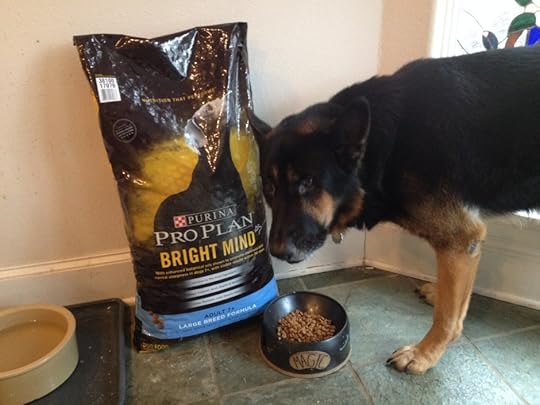
Magic loves the new food!
Reality check here—I’d kept him on the BRIGHT MIND food not because of any behavior improvement, but because he loved it and I knew it was good for a senior dog. With chicken as the first listed ingredient, and EPA (an omega-3 fatty acid) and glusamine in the formulation, the benefits are clear, whether there’s a behavior improvement or not. But about two weeks ago, when I noticed a dramatic behavior change that I have to attribute, at least in part, to the new food.
I think you can even tell in the pictures. Look at his face in the one next to the bag, and then compare it to the one I just took, below.

Magic loves his Bear, and wants to play fetch constantly.
He solicits play—insistently and incessantly. He not only hears me (at a whisper once again), but is more attentive than I can remember. He sleeps through the night, and his paw stress-licking has declined. When I ask him to “find Bear,” he no longer must search, but remembers exactly where he last left the toy. I have my Magical-Dawg back again—the energetic, engaged, play-play-play-NOW! attitude from three or four years ago has returned! Never mind the white on his muzzle, Magic acts like he could run a marathon.
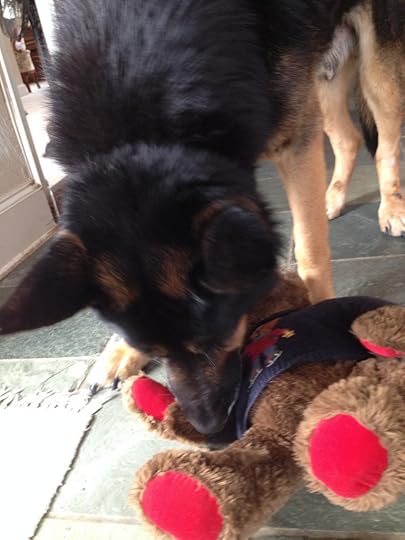
Magic loves his bear toy so much he bites and shakes him (that’s love!).
Yesterday morning at Magic’s annual wellness exam, he received a clean bill of health. Even his “senior dog” baseline blood panel looked great. What started out as professional curiosity and interest in an intriguing new nutrition concept has literally brightened the mind of my beloved Magical-Dawg. If you’re like me, you want that special bond to last forever—or at least as long as possible.
Now, if I could get ahold of those same enhanced botanical oils in the BRIGHT MIND food (an additional energy source for Magic’s brain) and add to my own diet, I would. Find out more about BRIGHT MIND here.
What about you? Do you have a dog age 7 or older? What sorts of aging changes have you noticed—and if you could turn back the clock, would you give it a try? Have you changed your dog’s food to a “senior” formulation?
Now’s the time to try. Spend $10 on any Purina® Pro Plan® product, 2/29-4/3. Save $10 on your next purchase of Purina® Pro Plan® Dry Cat or Dry Dog Food (14lbs. or larger) or Litter (6lbs or larger) by 5/1.
Note: Comments submitted may be displayed on other websites owned by the sponsoring brand.
 I love hearing from you, so please share comments and questions. Do you have an ASK AMY question you’d like answered? Do you have anew puppy and need answers? Stay up to date on all the latest just subscribe the blog, “like” me on Facebook, and sign up for Pet Peeves newsletter. Stay up to date with the latest book give aways and appearances related to my September Day pet-centric THRILLERS WITH BITE!
I love hearing from you, so please share comments and questions. Do you have an ASK AMY question you’d like answered? Do you have anew puppy and need answers? Stay up to date on all the latest just subscribe the blog, “like” me on Facebook, and sign up for Pet Peeves newsletter. Stay up to date with the latest book give aways and appearances related to my September Day pet-centric THRILLERS WITH BITE!
March 7, 2016
PET POISON! 7 Top Toxins & Pet 1st Aid to Keep Cats & Dogs Safe

Easter lilies are highly toxic to pets, especially cats. Be safe this Easter season!
National Poison Prevention Week runs March 20-26, 2016, and is a wonderful time to learn how to protect pets from household dangers. Most cases of pet poisoning are accidental, and preventing accidents and knowing pet poison first aid saves pet lives.
Dogs are particularly prone to poisoning because like human infants, they put everything in their mouths. Cats are more discriminating about what they eat, but contact poison can affect any pet if they walk through something toxic or it spills on fur and is licked off during grooming.
Symptoms vary depending on the poison, amount of exposure, and the individual animal. You may see anything from drunken staggers and collapse, to salivation, seizures, or hyperactivity.
7 TOP PET POISONS & FIRST AID HELP
Poisonings from human medications (both over-the-counter and prescription meds) has become the most common pet poisoning over the last several years. Dogs either gulp down tasty candy-coated pills, or owners give them human drugs without realizing the risks. Cats may play with pills, and accidentally swallow them. Be aware that pets don’t metabolize Tylenol, aspirin, ibuprofen or neproxin (Aleve) the same way people do, and can die from taking them. A single extra-strength Tylenol can kill a cat. Keep meds out of reach in pet-proof cabinets.
Chemical toxicity used to top the list but the safer flea and tick products have reduced the numbers of overdosing. Problems still happen when you misunderstand directions. What’s safe for a dog may be deadly for a cat! Wash your pet immediately if you suspect toxicity, and call the vet.
Plant poisonings are particularly dangerous to mouthy pets. Some varieties that can be harmful to pets include lilies, azalea, rhododendron, sago palm, kalanchoe and schefflera. Dogs fall victim most often because of their urge for recreational chewing. But some cats nibble leaves or paw-play with plants and may be poisoned when they later lick their claws clean. Beware of Easter lilies this holiday–learn more here!
Pest baits also tempt dogs and cats, and can poison pets that catch or scavenge poisoned rodents, roaches or snails. The same cereal grains often used in commercial pet foods also are used in rodent baits so dogs may willingly eat the poison. Anticoagulants like warfarin prevent blood from clotting, and cause uncontrolled and fatal bleeding from the rectum, nose, and even the skin. Pest poisons may take 24 to 72 hours to induce signs, but once the dog or cat shows distress, treatment may not be as effective and can be too late. Veterinarians have antidotes for some, and others require gastric lavage and supportive care. Pets may be poisoned by eating dead varmints that have succumbed to pest baits, too.
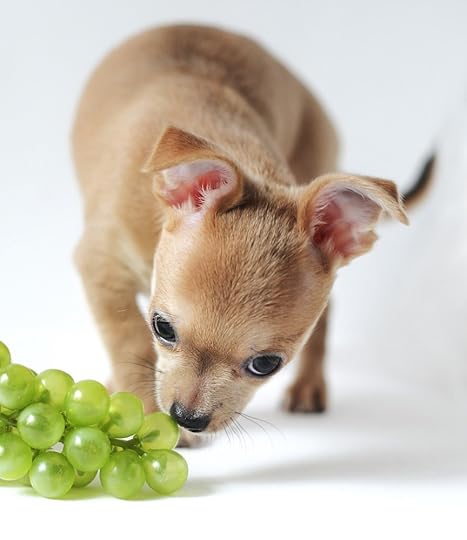
DANGER! Grapes are highly toxic and can quickly kill dogs.
5. Dogs love sweet flavors and often poison themselves by eating chocolate. Dark chocolate and Baker’s chocolate contains higher concentrations of the caffeine-like substance, theobromine, but even eating too much of that candy Easter bunny can prompt a bout of diarrhea and vomiting. Find out more about chocolate toxicity here.
6. Both fresh and dried grapes (raisins) are quite toxic in dogs. The exact poisonous substance that causes reaction isn’t known, and sensitivity varies from dog to dog. No dog should eat any amount of this fruit because even a small dose can be fatally toxic for your dog. Be particularly aware of wild grapes in the yard or fields.
The most dramatic and serious problem caused by grape/raisin toxicity is sudden kidney failure with lack of urine production. For unknown reasons, kidney failure is not seen in all dogs after ingestion of grapes or raisins. Researchers continue to investigate why some dogs die and others are not affected by the poison.
The first signs of distress often include vomiting and/or diarrhea with only a few hours of ingestion. After about 24 hours, you may see grapes or raisin pieces in the feces or vomitus. Affected dogs lose their appetite, become lethargic and unusually quiet. They may suffer abdominal pain, and “hunch” their back from the discomfort. Dehydration develops from the diarrhea and vomiting, but they only pass small amounts of urine. Eventually they stop urinating at all when the kidneys ultimately shut down. Prognosis is guarded, even when treated, and most dogs die once the kidneys stop producing urine. Grape/raisin toxicity is an emergency that needs prompt veterinary intervention.
7. Xylitol is a naturally-occurring sugar alcohol used for sweetening sugar-free products such chewing gum, candy, toothpaste and baked products. It also comes as a granulated powder. Both forms are highly toxic to dogs. Xylitol ingestion causes a rapid release of insulin in the dog, which in turn results in a sudden decrease in blood glucose levels. Depending on the size of your dog, a single piece of sugar-free gum may cause symptoms that result in death. The ingested substance may cause vomiting, incoordination, seizures, or even liver failure. Bleeding may develop in the dog’s gastrointestinal track or abdomen, as well as dark red specks or splotches on his gums. Usually the symptoms happen quickly, within fifteen to thirty minutes of ingestion, but some kinds of sugar-free gum may not cause symptoms for up to twelve hours.
FIRST AID FOR PET POISONING
If you see or suspect your dog has eaten toxic foods or substances, induce vomiting immediately (but only if the dog remains conscious). Take a sample of the vomitus or feces if available to help the doctor be sure of the diagnosis. You’ll find more tips on how to make pets vomit at this post.
If you suspect that your pet has been poisoned call your veterinarian or the ASPCA Animal Poison Control Center’s 24-hour hotline at (888) 426-4435. Details on specific signs and treatments of various poisons are also listed in “The First-Aid Companion for Dogs and Cats.” For more information on the ASPCA Animal Poison Control Center.
 I love hearing from you, so please share comments and questions. Do you have an ASK AMY question you’d like answered? Do you have anew puppy and need answers? Stay up to date on all the latest just subscribe the blog, “like” me on Facebook, and sign up for Pet Peeves newsletter. Stay up to date with the latest book give aways and appearances related to my September Day pet-centric THRILLERS WITH BITE!
I love hearing from you, so please share comments and questions. Do you have an ASK AMY question you’d like answered? Do you have anew puppy and need answers? Stay up to date on all the latest just subscribe the blog, “like” me on Facebook, and sign up for Pet Peeves newsletter. Stay up to date with the latest book give aways and appearances related to my September Day pet-centric THRILLERS WITH BITE!
PET POISON! 7 Top Toxins & How to Keep Cats & Dogs Safe

Easter lilies are highly toxic to pets, especially cats. Be safe this Easter season!
National Poison Prevention Week runs March 20-26, 2016, and is a wonderful time to learn how to protect pets from household dangers. Most cases of pet poisoning are accidental, and preventing accidents and knowing first aid saves pet lives.
Dogs are particularly prone to poisoning because like human infants, they put everything in their mouths. Cats are more discriminating about what they eat, but contact poison can affect any pet if they walk through something toxic or it spills on fur and is licked off during grooming.
Symptoms vary depending on the poison, amount of exposure, and the individual animal. You may see anything from drunken staggers and collapse, to salivation, seizures, or hyperactivity.
7 TOP PET POISONS & WHAT TO DO
Poisonings from human medications (both over-the-counter and prescription meds) has become the most common pet poisoning over the last several years. Dogs either gulp down tasty candy-coated pills, or owners give them human drugs without realizing the risks. Cats may play with pills, and accidentally swallow them. Be aware that pets don’t metabolize Tylenol, aspirin, ibuprofen or neproxin (Aleve) the same way people do, and can die from taking them. A single extra-strength Tylenol can kill a cat. Keep meds out of reach in pet-proof cabinets.
Chemical toxicity used to top the list but the safer flea and tick products have reduced the numbers of overdosing. Problems still happen when you misunderstand directions. What’s safe for a dog may be deadly for a cat! Wash your pet immediately if you suspect toxicity, and call the vet.
Plant poisonings are particularly dangerous to mouthy pets. Some varieties that can be harmful to pets include lilies, azalea, rhododendron, sago palm, kalanchoe and schefflera. Dogs fall victim most often because of their urge for recreational chewing. But some cats nibble leaves or paw-play with plants and may be poisoned when they later lick their claws clean. Beware of Easter lilies this holiday–learn more here!
Pest baits also tempt dogs and cats, and can poison pets that catch or scavenge poisoned rodents, roaches or snails. The same cereal grains often used in commercial pet foods also are used in rodent baits so dogs may willingly eat the poison. Anticoagulants like warfarin prevent blood from clotting, and cause uncontrolled and fatal bleeding from the rectum, nose, and even the skin. Pest poisons may take 24 to 72 hours to induce signs, but once the dog or cat shows distress, treatment may not be as effective and can be too late. Veterinarians have antidotes for some, and others require gastric lavage and supportive care. Pets may be poisoned by eating dead varmints that have succumbed to pest baits, too.

DANGER! Grapes are highly toxic and can quickly kill dogs.
5. Dogs love sweet flavors and often poison themselves by eating chocolate. Dark chocolate and Baker’s chocolate contains higher concentrations of the caffeine-like substance, theobromine, but even eating too much of that candy Easter bunny can prompt a bout of diarrhea and vomiting. Find out more about chocolate toxicity here.
6. Both fresh and dried grapes (raisins) are quite toxic in dogs. The exact poisonous substance that causes reaction isn’t known, and sensitivity varies from dog to dog. No dog should eat any amount of this fruit because even a small dose can be fatally toxic for your dog. Be particularly aware of wild grapes in the yard or fields.
The most dramatic and serious problem caused by grape/raisin toxicity is sudden kidney failure with lack of urine production. For unknown reasons, kidney failure is not seen in all dogs after ingestion of grapes or raisins. Researchers continue to investigate why some dogs die and others are not affected by the poison.
The first signs of distress often include vomiting and/or diarrhea with only a few hours of ingestion. After about 24 hours, you may see grapes or raisin pieces in the feces or vomitus. Affected dogs lose their appetite, become lethargic and unusually quiet. They may suffer abdominal pain, and “hunch” their back from the discomfort. Dehydration develops from the diarrhea and vomiting, but they only pass small amounts of urine. Eventually they stop urinating at all when the kidneys ultimately shut down. Prognosis is guarded, even when treated, and most dogs die once the kidneys stop producing urine. Grape/raisin toxicity is an emergency that needs prompt veterinary intervention.
7. Xylitol is a naturally-occurring sugar alcohol used for sweetening sugar-free products such chewing gum, candy, toothpaste and baked products. It also comes as a granulated powder. Both forms are highly toxic to dogs. Xylitol ingestion causes a rapid release of insulin in the dog, which in turn results in a sudden decrease in blood glucose levels. Depending on the size of your dog, a single piece of sugar-free gum may cause symptoms that result in death. The ingested substance may cause vomiting, incoordination, seizures, or even liver failure. Bleeding may develop in the dog’s gastrointestinal track or abdomen, as well as dark red specks or splotches on his gums. Usually the symptoms happen quickly, within fifteen to thirty minutes of ingestion, but some kinds of sugar-free gum may not cause symptoms for up to twelve hours.
FIRST AID FOR PET POISONING
If you see or suspect your dog has eaten toxic foods or substances, induce vomiting immediately (but only if the dog remains conscious). Take a sample of the vomitus or feces if available to help the doctor be sure of the diagnosis. You’ll find more tips on how to make pets vomit at this post.
If you suspect that your pet has been poisoned call your veterinarian or the ASPCA Animal Poison Control Center’s 24-hour hotline at (888) 426-4435. Details on specific signs and treatments of various poisons are also listed in “The First-Aid Companion for Dogs and Cats.” For more information on the ASPCA Animal Poison Control Center.
 I love hearing from you, so please share comments and questions. Do you have an ASK AMY question you’d like answered? Do you have anew puppy and need answers? Stay up to date on all the latest just subscribe the blog, “like” me on Facebook, and sign up for Pet Peeves newsletter. Stay up to date with the latest book give aways and appearances related to my September Day pet-centric THRILLERS WITH BITE!
I love hearing from you, so please share comments and questions. Do you have an ASK AMY question you’d like answered? Do you have anew puppy and need answers? Stay up to date on all the latest just subscribe the blog, “like” me on Facebook, and sign up for Pet Peeves newsletter. Stay up to date with the latest book give aways and appearances related to my September Day pet-centric THRILLERS WITH BITE!
March 2, 2016
Amy Shojai Featured in Wall Street Journal! Listen to AUTHORS ON THE AIR Tonight!

Kelly’s dog Kermit is reading SHOW AND TELL (and stole the pillow). After all, a dog’s gotta be comfy while reading, right?
Tonight at 9 pm (Eastern Time) I’ll be the kick-off guest for March’s WOMEN WRITERS’ MONTH at the awesome AUTHORS ON THE AIR program. I get to chat with Pam Stack along with guest host Rebecca Warner about SHOW AND TELL…and other writerly endeavors and books.
EDITED: It was a GREAT show, what fun! You can listen to the recording, too.
CLICK HERE to listen

DOT reads SHOW & TELL

Mike displays his paw-tographed poster.
There’s DOT with the paperback copy of SHOW AND TELL, and the “bonus” poster behind her. She’s in the paw-tographed poster, too, because Dot is one of the characters in the book. Her person, Kristi, entered and won one of the NAME THAT DOG spots.
Incidentally, there are still posters left. If you’ve read the book and reviewed it, send me the link and your snail mail address, and I’ll send one to you, along with the “bonus” chapter (in Shadow’s viewpoint).
Mike also got in on the act, and sent a picture of his paw-tographed poster, too. He lives with both cats and a dog, so probably didn’t want to play favorites. *s*
No way we can leave CATS out of the conversation. I happen to know that Pam, (the host of AUTHORS ON THE AIR) has some kitties of her own, so there’s likely to be some feline fun discussed, too. In fact…
My cat fiction expertise has now been FEATURED IN THE WALL STREET JOURNAL! Woot! This was a front-page story, no less, in a discussion of the pros and cons of having CAT characters in mysteries talk to the humans. Hey, my thrillers include cats and dogs, and Shadow (the service dog) has his own chapters, but none of my critters “talk” …other than with tail wags and ear twitches, of course. But that’s my preference as an animal behavior person. I have not problem with others imbuing their fictional felines with the ability to communicate. Don’t we all imagine what Kitty thinks and says, anyway?
The feature also included some information about several of my Cat Writers’ Association colleagues and the organization. Yes, there is a professional writer organization dedicated to a focus on the feline. You can read the WSJ article here.
My Karma-Kat and Seren-Kitty have been campaigning for cats to have their own viewpoint chapters in a novel, too, so…what do you think? After all, I’m an equal opportunity pet person and wouldn’t want to hiss off the cats.

Cats read by SITTING on top of books and absorbing the story through their (ahem) nether regions. Karma demonstrates the technique.
 I love hearing from you, so please share comments and questions. Do you have an ASK AMY question you’d like answered? Do you have a new puppy and need answers? Stay up to date on all the latest just subscribe the blog, “like” me on Facebook, and sign up for Pet Peeves newsletter. Stay up to date with the latest book give aways and appearances related to my September Day pet-centric THRILLERS WITH BITE!
I love hearing from you, so please share comments and questions. Do you have an ASK AMY question you’d like answered? Do you have a new puppy and need answers? Stay up to date on all the latest just subscribe the blog, “like” me on Facebook, and sign up for Pet Peeves newsletter. Stay up to date with the latest book give aways and appearances related to my September Day pet-centric THRILLERS WITH BITE!
February 27, 2016
Kitty Hide and Seek is Good for Cat Health: Neko Pawds Cat Tunnel Review
Do your cats play hide and seek? Does a shrinking violet cat dive under the bed whenever the doorbell rings? Or maybe you have a “pariah cat” that slinks around hoping the other cats won’t pay attention to the virtual KICK ME sign around her neck.
I’ve written about fearful cats in several behavior books, as well in this blog that explans why cats get scared, and offers 7 Tips to Stop Feline Fear including using tunnels and play. February is Responsible Pet Owners Month, so I’m always looking for great tips and products to share with my Sweet Peeps who adore their cats.
So when one of my favorite product manufacturers offered me the opportunity to review their new modular cat tunnels, I pounced at the chance. The UJI Tunnel System from NEKO PAWDZ is a modular system of fabric tunnels that can be mixed and matched into 20 different combination shapes.
I live with Karma-Kat…so checking out the product was a no brainer!
You see, Karma is a bit of a bully and Seren has learned to use tunnels to (literally) run under the radar to reach important spots, like the litter box. One of my top recommendations for boosting shy cat courage is offering safe hidey-holds. Encouraging interactive play also can give the bully cat something more productive to do, and wear out over-enthusiastic pounce-monsters.
Each modular tunnel opening has interlocking zipper fasteners to connect them into interesting configurations. The tunnels arrive collapsed neatly inside of mesh storage bags. There are three tunnel shapes:
A straight “I” shape, with multi-openings and a “crinkle” sound cats love (retail $55.00)
A bent “U” shape, with a 3rd opening in the middle (retail $75.00)
A hooked “J” shape, with its 3rd opening on top (retail $65.00)
Now, for those who say your cats are quite satisfied with a paper bag and empty cardboard boxes–that’s fine. It’s true cats don’t care how much you spend, and there likely are less expensive cat tunnels available. But as with other products from Nekochan, the quality of the fabric and safety (and desires) of the cats is built into each design. These cat tunnels are an investment in emotional health, and are so sturdy and well made, they should last for the lifetime of your current kitties and possibly beyond.
A simple loop-and-button holds the collapsed/stored tunnels together, and when released, the tunnel unfurls. There’s a safety pocket to tuck away the look and button when not in use. Each opening with it’s zipper lining is held in place with Velcro when not connected to another unit. That’s a GOOD thing, because my Karma likes to chew Velcro, for some reason. He didn’t seem to notice its presence in the tunnels.
You can mix and match how you want to connect the tunnels. I was sent three–but you can use a single unit, connect all three, or turn your home into a kitty tunnel paradise. Openings at both ends, and in the middle, offer lots of hide-and-seek (and ambush!) opportunities. The fabric is polyester, easily cleaned and brushed to remove cat hair, and designed to fit in any decor. Of course, the true test is . . . what does the CAT think?
I confined Karma while zippering the tunnels together. It took me just a bit to figure out how to do this (sort of have to hold your mouth right, LOL!) and was afraid the zippers would jam. Actually, the connection worked very smoothly, much better than expected. The stitching and construction has been carefully designed so it doesn’t catch, and now that I’ve connected them once, it’ll be a breeze in future when I re-do the configuration.
Actually, this is a great idea, too, to keep cats interested in something new. While the shy cats may be more than satisfied with set-in-place-and-leave-it-alone, my Karma-Kat relishes new challenges. So rather than having to buy a whole new set up, I can mix it up and change the design for him whenever I want.
In case he was reluctant to explore, I also brought out one of his favorite toys, the Kittenator lure toy, also from NEKOCHAN. But never fear, Karma is a Christopher Columbus of the cat world. As soon as I released him, Karma ran to investigate.
He immediately dove in head first, to explore this new playground. But first, he grabbed the toy and tried to take it inside with him.
The fabric on the hardwood entry slides a bit with exuberant play. I’ll move the tunnels into another carpeted room for a more permanent location. My dog Magic also was very interested in the tunnels. For households with both cats and dogs, this tunnel system would work great to give the cats a safe retreat.
I didn’t really expect Seren to explore the tunnels so quickly. But within minutes of Karma leaving, she scurried inside, too. Of course, then Karma decided to pester her and she left. In fact, here’s a short video of Karma and Seren first look at the tunnels.
The cats’ review was an enthusiastic ALL PAWS UP. As for me, I’m a huge fan of anything that will enrich the lives of our cats. There will be a bit of a learning curve to figure out the best way to put the tunnels together (or maybe not, I’m not great with puzzles myself!).
Environmental enrichment reduces cat stress, and cat stress has a negative impact on kitty health. So the more we can enrich our cat’s lives, enhance their emotional well-being, we’ll reduce health problems (and the cost of vet visits!). Hey, don’t believe me? Even the The American Association of Feline Practitioners promotes the Cat Friendly Practice (CFP) Program to help veterinary professionals reduce the level of stress associated with the clinic visit. They’re celebrating they have 1000 vet clinics now in the program, with a AAFP fun cat photo contest.
I really liked the notion of the tunnels being modular. Single tunnels can be used in different rooms, or a string of tunnels hooked together throughout the house. They’ll accommodate any size room, or any number (or size) cats.
The construction and attention to detail is wonderful, with the button-hiding and Velcro fasteners designed specifically with cat safety in mind. The material feels great, too. And while I anticipated Karma would like the tunnels, it surprised me how eagerly he raced to investigate. My only nit with the product would be the higher price might make pet parents reluctant to invest. Once they do, though, they’ll discover a quality product that will turn on the purrs.
Be sure to watch the video demo below as it will give you an even better idea of how the tunnels fit together and how the cats enjoy them. So, do you have cat tunnels for your cats? How do you enrich the environment for your kitties? Do tell!
This post is sponsored by Nekochan Enterprises, and I am being compensated for helping spread the word about UJI Tunnel system. Bling, Bitches & Blood only shares information relevant to our readers. Nekochan is not responsible for the content of this article.
 I love hearing from you, so please share comments and questions. Do you have an ASK AMY question you’d like answered? Do you have a new puppy and need answers? Stay up to date on all the latest just subscribe the blog, “like” me on Facebook, and sign up for Pet Peeves newsletter. Stay up to date with the latest book give aways and appearances related to my September Day pet-centric THRILLERS WITH BITE!
I love hearing from you, so please share comments and questions. Do you have an ASK AMY question you’d like answered? Do you have a new puppy and need answers? Stay up to date on all the latest just subscribe the blog, “like” me on Facebook, and sign up for Pet Peeves newsletter. Stay up to date with the latest book give aways and appearances related to my September Day pet-centric THRILLERS WITH BITE!
February 25, 2016
6 Easy Fresh Breath Tips & How to Brush Doggy Teeth (Without Getting Bit!)

Does the thought of brushing dog teeth make you cringe, roll your eyes, whimper, slink away–and feel guilty? You’re not alone. But once that puppy-sweet breath morphs into curl-your-eyebrows stench, it’s long past time to address that stink-icity.
By the time dogs (and cats!) reach the age of three, 80 percent of them have some amount of dental disease. The issue is so serious that veterinary dentists created February National Pet Dental Health Month to raise awareness. After all, pets don’t brush their teeth, and they tend to gulp—not chew—their food. Just think what your teeth would look like in three years if you never brushed!
Dogs (and cats) share a lot of the same dental issues with humans. A veterinary dental visit involves anesthesia, ultrasonic scaling, polishing, and sometimes fluoride treatment or antibiotics, especially if teeth are pulled.
You can reduce the number of veterinary dental treatments (and your guilt-factor) with easy home care tips. Here’s 6 no-guilt tips to freshen up your dog’s breath.
6 Easy Fresh Breath Tips
Dry food won’t “cure” dental disease, but it doesn’t stick to teeth as readily as wet foods. Crunching dry food can reduce dental problems by about 10 percent, though, so offering your dog “crunchies” after moist dinners can help.
Many dogs relish healthy people foods like raw veggies or fruit, and chewing on these “detergent” foods can help scrub teeth clean. Offer dogs carrots or apple slices for healthy natural dental snacks. Make ’em big pieces, too, so he must gnaw off a piece rather than gulp it whole.
PAW-Click Here! for Dog Safe People Foods PAW-Click Here! for DANGEROUS People Foods for Pets
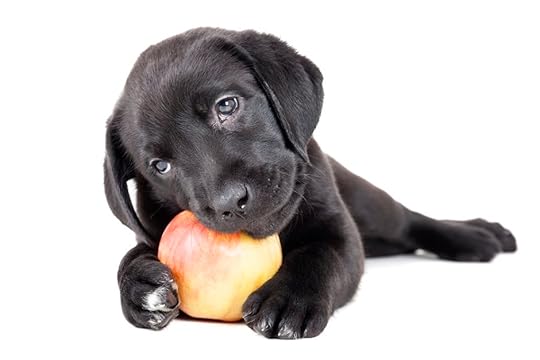
Eating “detergent” foods like apples is good for dog teeth.
Special “dental diets” and treats available in grocery stores or dispensed from the veterinarian can help especially with dog breeds that seem more prone to dental issues like Yorkshire Terriers. Look for sodium hexametaphosphate (sodium HMP) listed in the food, which helps prevent plaque from attaching to teeth.
Most veterinary dentists dislike cow bones, pig hooves, and other hard chew objects that may break your puppy’s teeth. Sterilized bones designed for doggy dental care, though, may be just the ticket.
Puppies love to chew. Offer your dog a legal object that also has dental benefits, like the “dental toys” that contain a nubby surface designed to scrub the teeth.
A wide range of commercial dental chews (rawhide, ropes, treats) available for dogs may also prevent doggy breath. Some are infused with special enzymes that kill bacteria and help prevent plaque. Also look for dental rinse products from your veterinarian.

Using a human toothbrush like this is too big for dog mouths, BUT…it works great to prop open the mouth for a pup-size brush to work!
How To Brush Doggy Teeth (Without Getting Bit!)
Adult dogs often object to tooth brushing. It’s best to start puppies with a dental hygiene program while they’re too little to argue. Just turn it into a tasty game and your pooch will BEG for the attention. Here’s how.
Mess With His Mouth. Over several weeks, get your dog used to having his mouth handled. You can get pups used to having something inserted into their mouth by flavoring your finger with low-salt chicken broth, or peanut butter (yum!).
Treat With Toothpaste. Offer doggy toothpaste as a treat. Special meat-flavored toothpaste is available from pet product stores or your veterinarian that gives pups the incentive to open wide. Never use human toothpaste. Puppies can’t spit so they end up swallowing the foam, and swallowed fluoride can be dangerous and damage your puppy’s internal organs.
Use Toy Props. Once they accept mouth handling and like the toothpaste, try propping the puppy’s mouth open with a favorite toy. Simply encourage him to bite on a chew object, and wrap your hand around his muzzle to hold it in place. That gives you access to his open mouth and also gives him something to do with his teeth. Use the same toy each time, so he identifies it with tooth attention–and getting a GREAT reward afterwards. Practice doing this several times and praising him while giving toothpaste treats before you introduce a toothbrush.
Choose Pet Brushes. Special pet toothbrushes are smaller and may be designed to better fit the dog’s mouth. A soft child’s toothbrush works well.
“Finger” The Teeth. Some puppies better accept your finger. Finger toothbrushes are available for brushing pet teet, or simply wrap a damp cloth over your fingers and use that to scrub the outside of his teeth. Puppy tongues clean the inside surface of teeth so you won’t have to worry about poking too far inside the mouth.
Praise The Performance. Brushing after every meal is recommended, but a two to three times a week is good. Always be sure to praise and throw a happy puppy party afterwards so your puppy is left with a good taste over the experience—literally!
Keeping breath fresh goes beyond good dental hygiene, too. Pungent breath makes you avoid dog kisses and lap snuggles (awww, you hurt his feelings!). It also points to potentially painful, dangerous dental problems that can damage your dog’s organs. Yes, it’s THAT important.
So…do you brush your dog’s teeth? What about offering “dental-friendly” foods and treats? How do you keep your pooch kiss-able fresh? Do tell!
 I love hearing from you, so please share comments and questions. Do you have an ASK AMY question you’d like answered? Do you have a new puppy and need answers? Stay up to date on all the latest just subscribe the blog, “like” me on Facebook, and sign up for Pet Peeves newsletter. Stay up to date with the latest book give aways and appearances related to my September Day pet-centric THRILLERS WITH BITE!
I love hearing from you, so please share comments and questions. Do you have an ASK AMY question you’d like answered? Do you have a new puppy and need answers? Stay up to date on all the latest just subscribe the blog, “like” me on Facebook, and sign up for Pet Peeves newsletter. Stay up to date with the latest book give aways and appearances related to my September Day pet-centric THRILLERS WITH BITE!
Thriller Thursday: Bryan Robinson & Limestone Gumption a Southern Mystery Delight
Chills, thrills and spills with Thrillers Thursday by Amy Shojai
THRILLER THURSDAY is a new occasional feature of Bling, Bitches & Blood. As a member of International Thriller Writers and alumni of the ITW Debut Author Program, it is my honor to showcase select ITW authors and books participating in the ITW Bloggers Program. If you love reading great books as much as I do, check out my guest Bryan Robinson!
 Bryan Robinson is a novelist and licensed psychotherapist. His award-winning thriller, Limestone Gumption: A Brad Pope and Sisterfriends Mystery, is a nail-biting Southern murder mystery and winner of the 2014 Beverly Hills Book Award for BEST MYSTERY. He is a veteran author of 35 nonfiction books, has appeared on 20/20, Good Morning America, World News Tonight, The Early Show, and NBC Nightly News. He maintains a psychotherapy practice in Asheville, NC, where he is working on Book 2 in the series, She’ll Be KILLING Round the Mountain When She Comes. Visit his website atwww.bryanrobinsonnovels.com, follow him on twitter @BRTherapist, and like him on Facebook https://www.facebook.com/bryanrobinsonnovels
Bryan Robinson is a novelist and licensed psychotherapist. His award-winning thriller, Limestone Gumption: A Brad Pope and Sisterfriends Mystery, is a nail-biting Southern murder mystery and winner of the 2014 Beverly Hills Book Award for BEST MYSTERY. He is a veteran author of 35 nonfiction books, has appeared on 20/20, Good Morning America, World News Tonight, The Early Show, and NBC Nightly News. He maintains a psychotherapy practice in Asheville, NC, where he is working on Book 2 in the series, She’ll Be KILLING Round the Mountain When She Comes. Visit his website atwww.bryanrobinsonnovels.com, follow him on twitter @BRTherapist, and like him on Facebook https://www.facebook.com/bryanrobinsonnovels
Hey, Sweet Peeps, ya gotta check out this book if only because his author picture includes….A DOG!
Winner of the 2014 Beverly Hills Book Award for Best Mystery
Finalist for Best Regional Fiction
Chosen by the NC Arts Council as one of the top ten best books for summer reading in July, 2014
Named number 8 in Malaprops Bookstore and Café’s Top Ten Best Hardback sellers for 2014
Finalist in the International Book Awards for Best Mystery/Suspense.
When Brad Pope returns to his boyhood hometown to settle a debt with his estranged father and re-establish a bond with his cantankerous Grandma Gigi, the 35-year-old psychologist becomes a prime suspect in the murder of football legend turned cave diver, Big Jake Nunn. As if being accused of murder isn’t shock enough, the psychologist is horrified by his father’s whereabouts. And Grandma Gigi and her club sisters start to look more like cold-bloodied killers than church ladies. This offbeat, fast-paced mystery witnesses beauty and brutality in a small Southern town, twisting and turning, teasing to the surface one suspicion, one misunderstanding, and one murder at a time.
PRAISE FOR THE BOOK
“A mystery that keeps us guessing as well as a humorous look at small-town Southern life. Bryan Robinson has written a highly enjoyable novel!”—RON RASH, New York Times bestselling author of Serena, a major motion picture
“Delightful story and memorable characters.”—CHRIS ROERDEN, Agatha-Award-winning author of Don’t Murder Your Mystery
“A stunning comedic debut, a laugh-out-loud page-turner of a mystery populated by the most eccentric and hilarious characters I’ve encountered in a long, long time.“–CASSANDRA KING, author of The Sunday Wife and Moonrise
“Thrilling, chilling, funny, touching with rich Southern characters and spot-on dialogue. I laughed, gasped, and even shed a few tears. I haven’t read a book I have enjoyed so much since THE HELP.“—DEL SHORES, Director/Screenwriter of the motion pictures Sordid Lives and Southern Baptist Sissies
“Colorful dialogue and larger-than-life Southern characters, earning it favorable comparison to the work of Fannie Flagg and Pat Conroy.”—RICH RENNICKS, Asheville Mountain Express
“Twists and turns and surprises kept me turning the pages…a little of everything: mystery, suspense, love, hate—an entertaining story.”—READERS’ FAVORITE
“Robinson’s debut amateur sleuth gets a thumbs up…light humor, genial banter, and colorful characters…mouthwatering recipes included.”—LIBRARY JOURNAL
BUY THE BOOK AT THESE FINE VENUES:
Amazon and Barnes & Noble
Subscribe to Amy’s YouTube Channel
I love hearing from you, so please share comments and questions. Do you have an ASK AMY question you’d like answered? Do you have a new kitten and need answers? Stay up to date on all the latest just subscribe the blog, “like” me onFacebook, and sign up for Pet Peeves newsletter. Stay up to date with the latest book give aways and appearances related to my September Day pet-centric THRILLERS WITH BITE!
February 17, 2016
Kitten Season! Must-Knows About Newborn Kitten Development

Mother cats take good care of kittens.
It’s kitten season–well, almost–and time for a refresher course on newborn kitten development. The timing is perfect (or purr-fect?) because this past week, I had a lovely kitty-girl visitor on my back patio.
The tortie youngster looked about five or six months old, and respectfully backed off and padded away when she saw Karma-Kat give her the hairy eyeball through the window. She looked well fed with a healthy coat and clean eyes, but at her age–and this time of year–it’s only a matter of time before she becomes pregnant. I hope that she’s already spayed and was safely shooed back inside once she returned home.

Newborn Kittens are blind and deaf, and use cries to call for mom and help.
ROMANTICAL CATS & KITTEN LITTERING
In the Northern hemisphere, intact girl kitties begin to go into heat in February, and can become pregnant as early as four or five months of age. Within about 63 days, new furry babies make their appearance so brace yourselves for a bumper crop of cute-icity.
Kittens gain two to four ounces a week from birth to five to six months of age. The kitten immune system is also fully developed by six to eight weeks of age, while the immune protection he gained from Mom begins to fade.

Kitten play can be relentless.
Nonstop Kitten Play
Play and interaction with others takes over during weeks five to seven. Social play with Mom and siblings begins now, and includes running, rolling, biting, wrestling, climbing, and jumping. Mom-cat and siblings let the baby know if he bites or claws too hard and they’ll hiss at him or put an end to the game.

Handraised newborn kittes need to be fed every 4 hours or so with an appropriate kitten milk replacement.
When kittens are adopted too early, or are orphaned and hand raised, you’ll have extra challenges to bringing up baby. What’s cute in a tiny kitten becomes aggravating or even dangerous when he gets older and can tip playtime into play aggression. Adopting a pair of kittens can be a good option, so the babies wrestle and play with each other rather than targeting your ankles. If you are the “mother figure” it’s up to you to teach Baby about the litter box, playing “nice” and eating grown-up food.

All your kitten must-knows!
Kitten Socialization For A Lifetime of Love
Puppies get more attention when it comes to socialization, but this is equally important in kittens. The problem is–prime kitten socialization takes place between two-to-seven weeks of age! Oh, the baby will learn after that, but his is the best time to pre-program a cat for success. When you adopt a kitten at this age, it’s up to you to expose him to a wide range of situations so he’ll be willing to accept them as he ages. That’s called “socialization” and can mean the difference between a loving pet and a scaredy cat. You can find important details in the COMPLETE KITTEN CARE book.
Good experiences with people and other pets during this time ensure they’ll be well-adjusted adult cats. It’s ideal for kittens to stay with their littermates and mother until twelve weeks of age so they learn best how to get along with other cats, and learn all the important “cat rules” of the world. But very often, shelters need the space and adopt out babies earlier–or the kitten is alone in the world anyway, and benefits from being adopted earlier.
He should learn to accept being handled and groomed by you and strangers, so the veterinarian won’t have to fight him for an examination. This is the best age to train him to accept the cat carrier and leash. That allows him to travel with you when necessary, either to the vet or groomers, or across town to visit Grandma. And if you think another pet (dog or cat), or a child might be in your future, introduce him to positive experiences at this age. That way, he’ll accept them as a normal part of his world and you’ll prevent behavior problems down the road.
How old was your cat when you adopted him? Have you ever needed to hand-raise a kitten? What do you think is the best age to adopt–and why? Please share!
Subscribe to Amy’s YouTube Channel
I love hearing from you, so please share comments and questions. Do you have an ASK AMY question you’d like answered? Do you have a new kitten and need answers? Stay up to date on all the latest just subscribe the blog, “like” me on Facebook, and sign up for Pet Peeves newsletter. Stay up to date with the latest book give aways and appearances related to my September Day pet-centric THRILLERS WITH BITE

